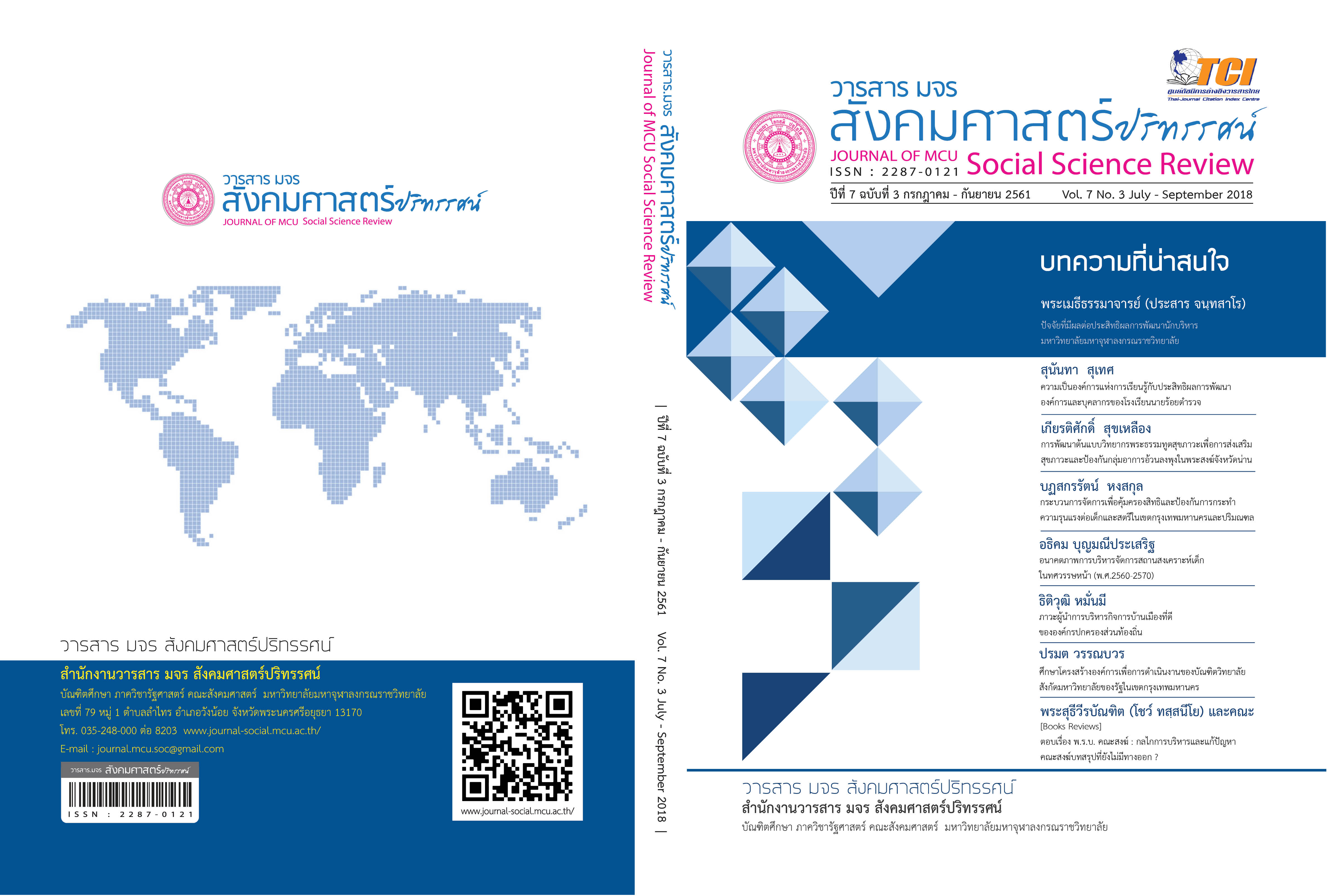รูปแบบการมีส่วนร่วมของพระสงฆ์ในการแก้ไขปัญหาการติดยาเสพติด ในเขตปกครองคณะสงฆ์ภาค 2
คำสำคัญ:
ปัญหายาเสพติด, การมีส่วนร่วมของพระสงฆ์, รูปแบบการแก้ปัญหาบทคัดย่อ
บทความนี้มีวัตถุประสงค์เพื่อ 1) ศึกษาวิเคราะห์สภาพทั่วไปเกี่ยวกับการมีส่วนร่วมของพระสงฆ์ในการแก้ไขปัญหาการติดยาเสพติด ในเขตปกครองคณะสงฆ์ภาค 2 2) ศึกษากระบวนการการมีส่วนร่วมของพระสงฆ์ในการแก้ไขปัญหาการติดยาเสพติด ในเขตปกครองคณะสงฆ์ภาค 2 และ
3) เสนอรูปแบบการมีส่วนร่วมของพระสงฆ์ในการแก้ไขปัญหาการติดยาเสพติดใน เขตปกครองคณะสงฆ์ภาค 2
ผลการวิจัยพบว่า
1. สภาพทั่วไปเกี่ยวกับการมีส่วนร่วมของพระสงฆ์ในการแก้ไขปัญหาการติดยาเสพติดในเขตปกครองคณะสงฆ์ภาค 2 พบว่า พระสงฆ์เข้าไปมีส่วนร่วมในการแก้ไขปัญหาการติดยาเสพติดอยู่ 10 ด้าน คือ 1) เทศนาหรืออบรมคุณธรรม จริยธรรม 2) เป็นวิทยากรให้ความรู้เกี่ยวกับ
ยาเสพติด 3) ร่วมกับทางจังหวัดจัดกิจกรรม “งดเหล้า เข้าพรรษา” “เทเหล้า เผาบุหรี่”4) จัดนิทรรศการรณรงค์ให้เห็นโทษภัยของยาเสพติด 5) ป้องกันปัญหายาเสพติดภายในวัด6) จัดอบรมพระสังฆาธิการและผู้บริหารโรงเรียน 7) ประสานงานกับเจ้าคณะผู้ปกครอง 8) ร่วมมือ
กับเรือนจา จัดแสดงธรรมขัดเกลานักโทษคดียาเสพติด 9) ขอความร่วมมือจากเจ้าหน้าที่ผู้เกี่ยวข้องหลายหน่วยงาน ในการแก้ไขอย่างจริงจัง 10) เข้าร่วมกิจกรรมของสานักงานสาธารณสุขจังหวัดโรงพยาบาลโดยส่งวัดเข้าประกวดวัดส่งเสริมสุขภาพ ลานวัด ลานกีฬา ต้านยาเสพติด
2. กระบวนการการมีส่วนร่วมของพระสงฆ์ในการแก้ไขปัญหาการติดยาเสพติดในเขตปกครองคณะสงฆ์ภาค 2 ประกอบด้วย 4 ขั้นตอนคือ ขั้นตอนที่ 1. การมีส่วนร่วมในการตัดสินใจได้แก่ 1) การมีส่วนร่วมในขั้นต้น 2) การมีส่วนร่วมขั้นเตรียมการ และ 3) การมีส่วนร่วมในขั้นตัดสินใจปฏิบัติการ ขั้นตอนที่ 2.การมีส่วนร่วมในการปฏิบัติการ ได้แก่ 1) การมีส่วนร่วมในการสละทรัพยากร 2) การมีส่วนร่วมในการบริหาร และการประสานงาน และ 3) การมีส่วนร่วมในการเข้าเป็นผู้ปฏิบัติในโครงการขั้นตอนที่ 3. การมีส่วนร่วมในผลประโยชน์ ได้แก่ 1) การมีส่วนร่วมรับ
ผลประโยชน์ในด้านวัตถุ 2) การมีส่วนร่วมรับผลประโยชน์ในด้านสังคม และ 3) การมีส่วนร่วมรับผลประโยชน์ในด้านบุคคล ขั้นตอนที่ 4. การมีส่วนร่วมในการประเมินผล ได้แก่ 1.การประเมินบริบทหรือสภาวะแวดล้อม 2.การประเมินปัจจัยเบื้องต้น 3.การประเมินกระบวนการ
4.การประเมินผลผลิตหรือผลงาน3. รูปแบบการมีส่วนร่วมของพระสงฆ์ในการแก้ไขปัญหาการติดยาเสพติดในเขตปกครองคณะสงฆ์ภาค 2 มี 5 รูปแบบ คือ รูปแบบที่หนึ่ง ร่วมคิด พระสงฆ์เข้าไปมีส่วนร่วมใน 4ขั้นตอน กล่าวคือ ขั้นระบุปัญหา ได้แก่ การแพร่ระบาดของยาเสพติดในกลุ่มพระสงฆ์ และเยาวชนขั้นหาสาเหตุ ได้แก่ สาเหตุ จากตัวพระสงฆ์เอง จากกลุ่มฆราวาสที่เกี่ยวข้อง ขั้นหาวิธีแก้ ได้แก่แนวคิด “กาแพง 7 ชั้น” ของ ศอ.ปส. ขั้นปฏิบัติการ ได้แก่ จัดทาเป็นนโยบายคณะสงฆ์และให้ความร่วมมือกับหน่วยงานที่เกี่ยวข้อง รูปแบบที่สอง ร่วมตัดสินใจ พระสงฆ์เข้าไปมีส่วนร่วมใน 4ขั้นตอน กล่าวคือ ขั้นระบุปัญหา ได้แก่ พระวินยาธิการขาดความรู้ในการแก้ปัญหายาเสพติด ขั้นหาสาเหตุ ได้แก่ ไม่มีหลักสูตรอบรม ไม่มีอานาจหน้าที่ มีอคติ 4 ขั้นหาวิธีแก้ ได้แก่ จัดอบรมถวายความรู้ เพิ่มอานาจหน้าที่ให้พระวินยาธิการ ขั้นปฏิบัติการ ได้แก่ หลักสูตรถวายความรู้พระวินยาธิการ เพื่อเป็นผู้นาแนวทางวัดสีขาวสู่การปฏิบัติ รูปแบบที่สาม ร่วมทา พระสงฆ์เข้าไปมีส่วนร่วมใน4 ขั้นตอน กล่าวคือ ขั้นระบุปัญหา ได้แก่ ขาดกิจกรรมที่เป็นประโยชน์แก่พระสงฆ์ พระสงฆ์มีเงิน และเวลาว่างมาก ขั้นหาสาเหตุ ได้แก่ ไม่มีหลักสูตรอบรมพระสงฆ์ที่บวชใหม่ ไม่มีกิจกรรมให้
พระสงฆ์ทา ขั้นหาวิธีแก้ ได้แก่ จัดทาหลักสูตรสาหรับพระบวชใหม่ เพิ่มกิจกรรมให้พระสงฆ์ทามากขึ้น ขั้นปฏิบัติการ ได้แก่ หลักสูตรศาสนศึกษา สาหรับผู้บวชระยะสั้น กิจกรรมสวดมนต์ เจริญภาวนา รูปแบบที่สี่ ร่วมติดตาม พระสงฆ์เข้าไปมีส่วนร่วมใน 4 ขั้นตอน กล่าวคือ ขั้นระบุปัญหา
ได้แก่ ขาดการกากับดูแล สอดส่องพระภิกษุสามเณรอย่างทั่วถึง ขั้นหาสาเหตุ ได้แก่ ไม่มีกระบวนการคัดกรองพระสงฆ์ที่เข้ามาบวชและอยู่วัด ขั้นหาวิธีแก้ ได้แก่ เพิ่มกระบวนการและขั้นตอนในการคัดกรองพระบวชใหม่และพระที่จะมาอาศัยอยู่ ขั้นปฏิบัติการ ได้แก่ กากับ ติดตาม
พฤติกรรมของพระสงฆ์อย่างต่อเนื่อง รูปแบบที่ห้า ร่วมรับผิดชอบ พระสงฆ์เข้าไปมีส่วนร่วมใน 4ขั้นตอน กล่าวคือ ขั้นระบุปัญหา ได้แก่ ขาดการแก้ไขปัญหาและเยียวยาพระสงฆ์ที่ติดยาเสพติด ขั้นหาสาเหตุ ได้แก่ เจ้าอาวาสเกิดความกลัวและภัยที่จะเกิดกับพระสงฆ์กลุ่มดังกล่าว ขั้นหาวิธีแก้ได้แก่ ทาความร่วมมือกับหน่วยงานที่เกี่ยวข้อง ขั้นปฏิบัติการ ได้แก่ อบรม และดูแลพระสงฆ์ที่ติดยาอย่างใกล้ชิด และให้กาลังใจเสมอ
ดาวน์โหลด
เผยแพร่แล้ว
รูปแบบการอ้างอิง
ฉบับ
ประเภทบทความ
สัญญาอนุญาต
ลิขสิทธิ์ (c) 2018 วารสาร มจร สังคมศาสตร์ปริทรรศน์

อนุญาตภายใต้เงื่อนไข Creative Commons Attribution-NonCommercial-NoDerivatives 4.0 International License.
เพื่อให้เป็นไปตามกฎหมายลิขสิทธิ์ ผู้นิพนธ์ทุกท่านต้องลงลายมือชื่อในแบบฟอร์มใบมอบลิขสิทธิ์บทความให้แก่วารสารฯ พร้อมกับบทความต้นฉบับที่ได้แก้ไขครั้งสุดท้าย นอกจากนี้ ผู้นิพนธ์ทุกท่านต้องยืนยันว่าบทความต้นฉบับที่ส่งมาตีพิมพ์นั้น ได้ส่งมาตีพิมพ์เฉพาะในวารสาร มจร สังคมศาสตร์ปริทรรศน์ เพียงแห่งเดียวเท่านั้น หากมีการใช้ภาพหรือตารางหรือเนื้อหาอื่นๆ ของผู้นิพนธ์อื่นที่ปรากฏในสิ่งตีพิมพ์อื่นมาแล้ว ผู้นิพนธ์ต้องขออนุญาตเจ้าของลิขสิทธิ์ก่อน พร้อมทั้งแสดงหนังสือที่ได้รับการยินยอมต่อบรรณาธิการ ก่อนที่บทความจะได้รับการตีพิมพ์ หากไม่เป็นไปตามข้อกำหนดเบื้องต้น ทางวารสารจะถอดบทความของท่านออกโดยไม่มีข้อยกเว้นใดๆ ทั้งสิ้น





